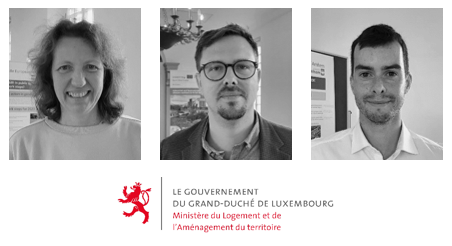Luxembourg's Ministry for Housing and Spatial Planning is a special partner within IB-Green: They're the only project partner in our consortium coming from Luxembourg! Together, Juliette Mathieu, Maurice Nilles and Daniel Martin are working on the IB-Green activities.

What was the main reason that you decided to become a project partner for IB-Green?
The Department of Spatial Planning (DATer, Département de l’aménagement du territoire) of the Ministry for Housing and Spatial Planning, as national planning authority, is involved in the spatial distribution of new industrial and business parks (IBPs) on a national level in Luxembourg. Furthermore, the DATer guides municipalities in the implementation process of these areas at local level. In order to reduce land consumption, it is essential to rethink and reshape existing IBP’s.
Facing challenges posed by climate change and social issues, Luxembourg in Transition is striving to develop strategic land-use planning solutions and produce ecological transition scenarios by 2050 for the Grand Duchy of Luxembourg and its cross-border territories. An international consultation has been launched in June 2020 and finished in January 2022. The transformation of existing IBPs has been identified as one main challenge by the international teams participating.
The DATer aims to reduce heat production in IBPs by implementation of green-blue infrastructure and to cooperate with regional and local planners as well as companies to increase the awareness for the need to (re)built IBPs sustainably, implementing an integrated approach to use IBPs in a multifunctional way and to better connect them to the living places of people.
What previous activities have you implemented (or which projects have you been involved with) concerning blue and green infrastructure in industrial and business parks?
The DATer, together with the Ministry of Economy, has elaborated a sectoral master plan for business parks (Plan directeur sectorial “zones d’activités économiques”, PSZAE), whose main objective is to encourage the creation of national and regional business parks by defining land areas specifically intended for the establishment of economic activities. The PSZAE is binding since March 2021.
Since another objective is to encourage municipalities to develop and implement inter-municipal strategies by developing and managing regional business parks, a guide for the sustainable design of IBPs has been elaborated. This document provides guidance for the sustainable implementation of the sectoral master plan in the various planning phases.
Furthermore, the guide explains the central fields of action of the circular economy, shows the advantages of cycle-orientated planning of activity zones and provides suggestions for text modules at a local level that can be used in the municipal regulatory instruments.
Amongst others, the guide focuses on multifunctional roofs & facades, water supply & disposal, nature & landscape, as well as local recreation & open spaces. This guide (in German) can be consulted here.
Which activities/pilot action of another IB-Green project partner do you find interesting, or do you think you can learn from the most?
The project activity “IB-Green award” of PP07 – Wila Bonn is particularly interesting, especially since similar financial incentives exist in Luxembourg in the field of climate and environment.
The DATer believes that such a measure can be complementary to the future recommendations for more climate resilient IBPs which will result from our study.
What do you think is the best part about working with project partners from North-West-Europe?
The best thing about the Interreg NWE project IB-Green is the exchange between partners, although coming from different countries and having different legal norms and administrative levels, who face identical problems or challenges when it comes to climate adaptation and territorial resilience. Being so, partners participate pro-actively in a manner that guarantees the best project outcome.
What do you think is most important when convincing people to become active for climate adaptation?
IB-Green gives the different actors – at national and local levels – a unique opportunity to raise awareness about land use and climate change, above all the municipalities themselves. Even if IBPs occupy only a small part of the territory of our country, they need to be planned and designed in a very specific way to fulfill the role of a healthy and sustainable working place.
Hence, an essential element is convincing people that, on the long run, investing in climate adaptive measures will ultimately benefit them – for instance, but not only, financially.
